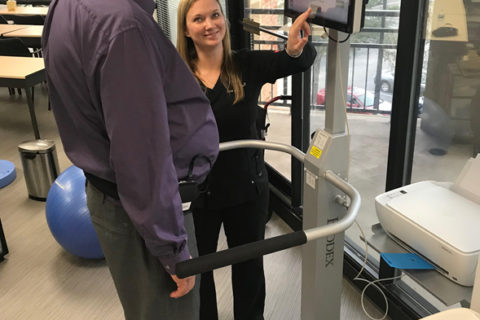
This Fall… Don’t
Published on: August 20, 2018
According to the National Institutes of Health, balance related falls are the leading cause of accidental death in the 65-year-old and plus populations. Falls also account for extensive amounts of injury and costs including over 2.8 million Emergency Room visits and over three billion dollars to Medicare and Medicaid, not to mention the cost of pain and loss of independence. Although it is impossible to guarantee that individuals can prevent a fall, we can certainly take care to reduce the odds to be more favorable. The following are common factors and risks to be considered with fall prevention: 
- Dizziness getting in or out of bed- check for BPPV and treat accordingly
- Near syncope or severe light-headedness rising off the commode or standing from a seated or supine position – orthostasis related to blood pressure or recent changes in medications
- Poor vision or light adaptation – secondary to common age-related co-morbidities (glaucoma, macular degeneration or diabetic neuropathy)
- Polypharmacy- interaction of prescription medications
- Home hazards – is the home environment safe and free of hazards including pet toys, sufficient lighting, rugs, etc.
- Appropriate footwear- Flip flops and other footwear may need to be modified
- Medical co-morbidities conditions which are known to have higher prevalence of falls, e.g. diabetic neuropathy, Parkinson’s and dementia
CASE STUDY
72-year-old male with chronic imbalance and onset of falls over the past 3 months. Two falls outside of home, one fall in home in kitchen preceded by dizziness. Medical history includes, diabetes type II and Parkinson’s (both controlled). Also, recent onset of positional vertigo (when supine, lasting only minutes or less) in the past 3 months with onset just prior to the increased difficulty with ambulation. Occasional reports of dizziness with when reading. History of cervicospinal discomfort post motor vehicle accident (MVA) several years prior. MRI studies reported as unremarkable.
Evaluation
ENT Exam: Unremarkable
Vestibular-Balance Assessment:
- VNG – positive for right ear PC-BPPV, abnormal caloric responses bilaterally total of 23 deg./sec (12 and 11 degrees right and left ears respectively)
- Rotary Chair: Reduced gain bilaterally with bidirectional rotation (velocity step test)
- cVEMP – bilaterally absent responses
- Computerized Dynamic Posturography (CDP)- Abnormal SOT, MCT and Adaptation sub-tests, consistent with low vestibular function, and surface preference
- Sensation- Reduced sensation plantar aspect of both feet with monofilament testing
- Timed Up and Go Test (TUG)- 15 seconds (Abnormal)
- Dynamic Gait Index (DGI)- Score 16 (Abnormal)
- Cervical Spine evaluation-decreased range of motion (ROM) throughout with complaint of dizziness with sustained cervical flexion. + Smooth Pursuit Neck Torsion Test (SPNT) with reproduction of dizziness. + Joint Position Sense (JPS) test for decreased proprioception awareness with (B) cervical active rotation (R)>(L). Subjective report of pain in neck: 6/10 on Visual Analog Scale (VAS)
Problem List
- BPPV (R)
- Decreased cervical ROM, postural awareness and joint position sense, and +SPNT test
- Hypofunction of the vestibular system and decreased sensation of lower extremities, resulting in equilibrium deficiency and surface dependency
- Gait and balance deficits
- Co-morbidities-Parkinson’s, Type II Diabetes
Goals/Objectives
- Eliminate positional vertigo through Canalith Repositioning Manuever (CRM)
- Improve cervical ROM, strength, joint position sense and postural awareness for improved safety with driving (looking over right/left shoulder) and with functional mobility
- Improve clinimetric score (TUG and DGI), indicating a reduction in fall risk
- Gait and balance training to restore safe household and community ambulation
- Patient to be independent with the implementation of fall prevention strategies, including home exercise program, gait training, and patient education
Plan of Care
- Treat and clear right ear PC-BPPV with Canalith Repositioning Gans/Semont Maneuvers
- Manual therapy to the cervical spine, focusing on restoration of AROM. Initiate therapeutic exercise program focusing on ROM, strength, and joint position sense, and postural awareness
- Gait training activities focusing on safe ambulation with appropriate footwear and/or assistive device
- Balance activities-focusing on dynamic activities and surface challenges
- Patient education on fall prevention strategies within the home and community
Outcomes
- After completion of CRM for PC-BPPV, the patient reported resolution of vertigo. (-) for BPPV testing
- Improved Cervical AROM, (-) SPNT, (-) JPS, resolution of dizziness with reading. Decreased report of pain on VAS from 6/10 to 1/10 at discharge
- Improved clinimetric scoring: TUG score improved to: 11 seconds, DGI score improved to: 21
- Independent ambulation with footwear adjustments and use of front wheeled walker for safety